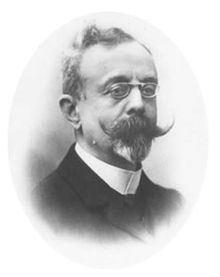Antonio Favaro
Antonio Favaro (born May 21, 1847 in Padua ; † September 29, 1922 there ) was an Italian engineer and science historian, known as the editor of the works of Galileo Galilei .
Favaro came from a noble and educated family (his father was also a mathematician) and studied mathematics among others with Domenico Turazza at the University of Padua with the degree in 1866. He then studied to become an engineer, with a degree in 1869 at the University of Turin, after which he went to the Zurich Polytechnic . But he returned as early as 1870 to become assistant to his teacher Turazza in Padua at the chair for rational mechanics, who also became his father-in-law. In 1872 he became an associate professor for graphic statics and in 1882 a full professor. He also gave lectures in the history of mathematics. The turn to it happened under the influence of Baldassare Boncompagni and his Bulletino.
He published, among other things, on the history of continued fractions and Galileo, but especially on the history of the University of Padua.
He published a number of Galileo's writings in the Bulletino of Boncompagni and in 1881 proposed a complete edition of Galileo's works to the Istituto Veneto. In 1887 this was officially approved by the Italian state and the first volume was published under the editorship of Favaro in 1890, the twentieth and last in 1909. However, only 500 copies were printed. An improved new edition appeared from 1929 to 1939, edited by Antonio Garbasso and, after his death, by Giorgio Abetti (in collaboration with Angelo Bruschi and Enrico Fermi ).
During the editing period, Favaro published further works on Galilei and his environment, including the series of articles in 40 parts Amici e corrispondenti di Galilei from 1894 to 1919 (reprinted in 1983 by Paolo Galuzzi in three volumes). He also published monographs on Galileo's opponents ( Oppositori di Galileo , 1892 to 1921 in six parts and Adversaria galileana , in seven parts from 1916 to 1923, reprinted in 1992) and Scampoli galileiana (1892 to 1914).
Most recently he was involved in the national edition of Leonardo da Vinci 's works (Commissione Vinciana), of which he also edited the writings on the movement of water with Enrico Carusi (Del moto e misura dell'aqua, 1923). The Accademia dei Lincei he belonged since 1918 as a corresponding member.
Fonts
- The studio di Padova e la compagnia di Gesù sul finite del decimo decimosesto. 1878.
- Le matematiche nello studio di Padova dal principio del secolo XIV alla fine de XVI. 1880.
- Galilei e lo studio di Padova. 1883.
- Miscellanea galileiana inedita. 1887 (unpublished works by Galileo, around 300 pages).
- Atti della nazione Germanica artista, nello Studio di Padova ( it ), volume 1. Tipografia Emiliana, Venice 1911.
- Nuovi studi galileiani. 1891.
- Saggio di bibliografia dello studio di Padova 1500–1920. 2 volumes. 1922.
As editor:
- Le opere di Galileo Galilei. 20 volumes, Florence 1890 to 1909, reprints with additions Florence 1929 to 1939, 1964/1965.
literature
- Massimo Bucciantini: Favaro, Antonio. In: Fiorella Bartoccini (ed.): Dizionario Biografico degli Italiani (DBI). Volume 45: Farinacci – Fedrigo. Istituto della Enciclopedia Italiana, Rome 1995.
- Joseph W. Dauben , Christoph J. Scriba (eds.): Writing the history of mathematics , Birkhäuser 2002, p. 428
Web links
- Fàvaro, Antonio. In: Enciclopedie on line. Istituto della Enciclopedia Italiana, Rome. Retrieved April 11, 2017.
Remarks
- ↑ Annuario dell'Accademia Nazionale dei Lincei 2011, p. 438
| personal data | |
|---|---|
| SURNAME | Favaro, Antonio |
| BRIEF DESCRIPTION | Italian historian of science |
| DATE OF BIRTH | May 21, 1847 |
| PLACE OF BIRTH | Padua |
| DATE OF DEATH | September 29, 1922 |
| Place of death | Padua |

